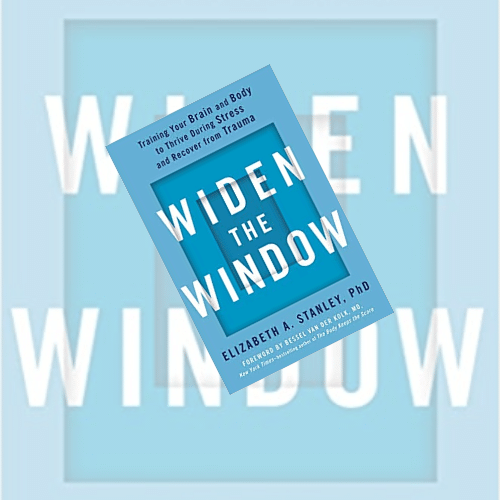Table of Contents
Synopsis Review And Lessons From Enlarge The Window
Introduction
Window ...A pioneering researcher provides us with a fresh understanding of stress and trauma in addition to the means to recover and thrive.
Join Dr. Elizabeth Stanley for a book release conversation on the neuroscience of stress, trauma, and resilience, as well as their impact on national security and foreign policy.
Human neurobiology, for instance, has combined with specific aspects of the post-9/11 military (as well as its given objectives) to lead to the huge increase in suicides and physical and mental health problems among military service members and veterans since 2001.

Similarly, stress and emotion contagion — two impacts of our social neurobiological wiring – intensify severe polarizations in the United States, particularly with regards to race and gender.
The microdynamics of decision-making under stress and trauma exacerbate the tendency to prolong conflicts.
Widen the Window investigates the social practices that inhibit resilience in the United States, particularly our collective propensity to detach stress from its effects and to disregard the need to recuperate
. In addition to exploring the science behind stress, trauma, and resilience, this book examines how recovery and resilience are trainable skills.
It combines tales with experimental and empirical data, including data from four Department of Defense neurology studies with U.S. military personnel regarding the effectiveness of Mindfulness-based Mental Fitness Training (MMFT)®, a resiliency program designed by Stanley.
Our internal reaction to an incident that our brain interprets as scary or difficult.
Trauma is your response to a situation in which we feel helpless or without control. In the past, scholars have seen these circumstances as distinct, although in reality they exist along a continuum.
Dr. Elizabeth Stanley describes the relevance of this continuum, how it influences our resilience in the face of adversity, and why a stressful experience for one individual can be traumatic for another.
This ground-breaking book investigates the cultural norms that limit resilience in the United States, particularly our communal propensity to detach pressure from its potentially dire repercussions and to prioritize our desire to recover.
It describes the science behind how to focus our attention in order to perform well under pressure and heal from trauma.
Even within extreme-stress circumstances, we can exercise autonomy with training. In truth, every maladaptive habit or reaction conditioned by stress or trauma can indeed be reprogrammed and cured with intention and comprehension.
The idea is to employ tactics that tap into both the thinking and survival brains.
By focusing our attention in specific ways, we can enlarge the window in which our cognitive brain and survival brain can operate jointly.
When we utilize consciousness to govern our biology in this manner, we can access our most admirable, distinctively human characteristics: empathy, bravery, enthusiasm, creativity, and connectedness.
By cultivating resilience, we may train ourselves to make prudent judgments and have access to options, even during times of extreme stress, unpredictability, and transformation.
Including tales from men and women Dr. Stanley has given training in settings as diverse as army facilities, health clinics, and Capitol Hill.
In addition to her own harrowing personal experience with stress and trauma, she provides the readers with methodologies they can use theirself, whether they want to perform well under pressure or recover from a traumatic experience, while also advancing our understanding.
Eliminate trauma and optimize your potential. If you have experienced a catastrophic personal tragedy, you understand how difficult it can be to live in the present.
On most occasions, you may feel happy to have even gotten out of bed; forget about reaching your full potential! However, according to military psychologist Elizabeth Stanley, you do not have to spend your entire life stuck in your trauma.
Widen the Window (2019) examines the science of top psychology studies and the recommendations of trauma professionals to present a how-to guide towards liberation.
What do you perceive “trauma” to be? Is PTSD exclusive to war veterans and women who have been abused? Or do you consider that trauma is a common occurrence that can afflict anyone at any time?
Many people assume that an activity is only traumatic if it fits under the heading of “the very worst type of event you can possibly endure.” However, the author’s research reveals that this is not true. In reality, trauma is described as any very distressing or troubling experience.
And although we commonly believe that “stress” and “trauma” are two quite different things, the mounting tension of college coursework or the pressure of caring for wailing children can be traumatic under certain conditions.
Every day, many people struggle with unresolved and untreated trauma due to the pervasiveness of trauma. And throughout this overview, we will examine the author’s findings and discover how to recognize trauma, address it, and move on.
Chapter 1
The Impact Of Stress And Trauma
Students frequently competed in a “contest of pain” when I was in college. For instance, someone might say, “I only slept for three hours yesterday night!” Someone else then said, “I only have thirty minutes!”
Someone else may then chime in for the victory by asking, “Are you guys sleeping?” In spite of the fact that none of these activities are healthy, students frequently competed in this manner as if we were receiving awards for stress.

The greater our stress levels, the greater our bragging rights. If you find this society to be exceedingly toxic, you are correct; it was! But our university was simply a microcosm of a much larger problem: the social prestige we accord to stress.
Whether at the university or in the business, our society appears to have accepted the fact that we shall all suffer constantly.
Because humans are naturally inclined to construct hierarchies, we honor those who appear to be under the most pressure. This situation is bad for numerous reasons!
When we praise high levels of stress, we send the message that functioning under enormous strain is normal. However, this mindset is also harmful because it teaches individuals to connect production with stress.
While a certain level of intensity is unquestionably beneficial for motivation, intensity and stress (or pressure) are vastly dissimilar.
In truth, intensity is frequently pleasurable; we seek a certain level of intensity because it stimulates our minds and motivates us to surpass our own bests. However, this is substantially different from the sensation of being pulverized by competing responsibilities.
Consequently, whenever our society gives such profoundly contradictory messages, we urge people, particularly young kids, to believe that they cannot be successful unless they are suffering.
And when worry crosses over into suffering, we have successfully transformed it into trauma. And after a certain point, our bodies’ fight-or-flight reflexes are unable to distinguish between a looming deadline and a potential death danger.
This means that our bodies will soon be conditioned to believe that they are under constant attack. And this continual feeling of fear can swiftly escalate to the hypervigilance and panic observed in those with severe PTSD.
As shocking as it may sound, a handful of seemingly typical life experiences are in fact anything but. Due to a culture that praises stress, we have been conditioned to assume that stressors are innocuous.
Nonetheless, this does not imply that every stressful encounter is traumatic. Daily annoyances and tragic situations are polar opposites. But trauma does emerge on a continuum.
Therefore, it is exceedingly improbable that a tense phone call or an hour spent in traffic caused rapid PTSD. However, four years of believing that your entire self-worth and life depend on your academic success and your ability to meet impossible deadlines could leave you devastated.
Chapter 2
Your Body Remembers Your Stress
If you’re like the majority of people, it’s generally safe to assume that you don’t get 8 hours of sleep each night. For the majority of people, the recommended amount of sleep is frequently cut in half.
Occasionally, it is even less, as evidenced by the university students who boasted about their sleep deprivation. Since this pattern of sleep deprivation is so prevalent, you are likely aware with the term “sleep debt.”

According to the American Sleep Society, “sleep debt, sometimes referred to as sleep deficit, defines the cumulative effects of inadequate sleep.
It is crucial for individuals to realize that a significant sleep deficit might result in physical and/or mental weariness. Total sleep deprivation and partial sleep deprivation result in the two types of sleep debt that are recognized.
Total sleep deprivation occurs when an individual is kept awake for at least 24 hours, whereas partial sleep deprivation happens when a human or lab animal sleeps less than usual for several days or even weeks.”
As this example demonstrates, your insufficient sleep can have a significant and negative effect on your everyday life and cognitive performance.
Additionally, it is nearly hard to catch up or “pay off” a sleep debt. This is due to the fact that your body remembers the lost sleep; the sleep deficit literally accumulates in your body, causing physical symptoms.
Sadly, the same holds true for catastrophic experiences. Consequently, if your body is perpetually in “survival mode” due to perceived threat or chronic stress, the impacts of operating in survival mode will accrue in your body.
For instance, if you are in a psychologically abusive relationship, you may not experience physical blows every day, but you are still in danger because your partner is gaslighting you and abusing you.
You may feel the need to reassure yourself, “I’m alright! This method won’t work in the long run, even if it’s necessary to say “Everything is fine” to live each day.
You may be able to fool your brain slightly, but your body still knows what’s happening. Your body is aware that it is under attack, and it continues to absorb and store stress.
Therefore, adequate healing is essential. However, in order to recuperate, your mind and body must think they are secure. Unfortunately, though, this is not always as simple as it sounds.
To comprehend how the recuperation process operates, we can visualize it in practice. For instance, suppose you were in an abusive relationship and ultimately got the courage to leave.
Therefore, you leave your lover, alter your phone number, and cease all communication. After removing your abuser from your life, you make it to your parents’ home, where you can recuperate.
Your parents are nothing but supportive, and you have nothing to worry about; at this point, all you need to do is relax and concentrate on getting better.
Sadly, your body is unaware of this fact. Even if the threat is no longer present, your body has not fully acknowledged that it is now safe. In actuality, the absence of the threat has allowed your body to recognize just how much you have endured.
Therefore, in a somewhat safe atmosphere, your body and thoughts are free to panic as they fully understand and process the consequences of what occurred.
Consequently, dysregulation ensues. Laura Angers, a trauma psychologist, defines psychiatric symptoms as the professional term for a difficult-to-control emotional state, including poor habits of emotional coping, a propensity for emotional outbursts, and an inability or difficulty to communicate emotions properly (if at all). 7
Dysregulation is a consequence of complex trauma. Your bodily and emotional reactions have been altered or disorganized as a result of a profoundly traumatic event or the effects of prolonged stress.
Consequently, you may have difficulty processing events or emotional inputs in a “normal” or adequately regulated manner.
In the hypothetical scenario outlined above, for instance, dysregulation may indicate that your body and brain cannot accept the notion of safety.
Even after the threat has passed, your mind and body have been so transformed by continuous exposure to survival mode that they find it difficult to comprehend that you are now safe.
You may suffer hypervigilance, memories, and a heightened startle response as a result. You may experience unexplainable emotional outbursts or inappropriate emotional responses to situations.
All of these are typical among PTSD sufferers. These responses may impede the facilitation of a healthy and regenerative recovery process. Thankfully, this does not indicate that recovery is impossible.
Chapter 3
Widening Your Window
Now that we have discussed the nature and effects of trauma on the mind and body, it’s time to return to the book’s title: expanding your perspective.
However, what does the term “window” signify in the context of trauma? And why is it essential? However, the author argues that everyone has their own window.
This window is metaphorical in the same way that the expression “They have a lot on their plate” is metaphorical. Therefore, this window indicates your personal capacity to deal with stress.

Managing your stress, on the other hand, is not the same as being buried by your tension and continuing to drag yourself through life. In this context, “managing your stress” refers to your capacity to do so in a healthy and comfortable manner.
For instance, if you are managing well with the amount of stressors, you may return home from a long, difficult day at work, vent to your friends or family, take a soothing bubble bath, and then go to bed.
In contrast, if you are unable to manage your stress, you may resort to unhealthy coping techniques, such as binge drinking or dangerous pleasure-seeking activities, which bring only short comfort.
This distinction allows us to contextualize your window. At your best, your window of stress should be broad enough to allow you to manage and self-regulate a wide range of stressful situations with relative ease.
Therefore, a healthy window is wide. But what happens to this window if you encounter continuous stress or a traumatic event?
If your pressure becomes intolerable, your window of opportunity begins to narrow. You lose the capacity to comfortably manage stress. Because the pressure you are under is so intense, you cannot handle any further stress.
Consequently, your window becomes smaller and smaller. As a result of your inability to self-regulate, dysregulation may force you to exclusively engage in unhealthy coping techniques.
You may also suffer intense anxiety or agitation as a result of minor incidents, such as stumbling over an object or dropping your keys.
And, as you may have predicted, this limited window can make it nearly impossible to function well at work and cultivate good relationships.
So, how can you overcome these difficulties? How might you expand your window? The author believes that mindfulness and cognitive exercises can assist us in overcoming trauma, broadening our perspectives, and working towards healing.
To begin with, she suggests engaging your “thinking brain” in order to process your trauma. You can consider your thinking brain to be the antithesis of your “survival brain.”
Your survival brain is responsible for identifying and defending you from potential threats. It is effective due of its reliance on primitive, physical indicators, such as your stress responses.
However, this also implies that your survival brain is incapable of processing logical, reasoning messages such as “the threat has been eliminated and I am now safe.”
And this is where your intellect comes in. Your thinking brain cannot command your survival brain to be quiet or disregard the signals it receives, but it may help to balance them. And using your thinking brain to comprehend and overcome your trauma is an excellent starting point.
To start the process, the author suggests writing down a list of all traumatic events you have endured. You may go as far back as your adolescence and add seemingly “insignificant” events that had a significant impact on you.
Remember that your trauma is valid, even if it makes you feel foolish or as if it shouldn’t be a huge concern. If it had a traumatic impact on you, it should be included.
Once you have compiled a list of your traumas, the following stage is to categorize your causes of stress.
For instance, perhaps the traffic on your morning drive makes you really irritated. Perhaps you are under pressure to care for your children, prepare a three-course supper, and fulfill project deadlines simultaneously.
Whatever your stress may be, it should be listed! The next stage is to determine the coping techniques you use to manage stress. Even if they are unhealthy or embarrassing, record them.
This workout may appear easy, but it is an excellent way to begin your rehabilitation. Because once you understand your trauma and coping strategies, you are one step closer to processing it rather than being overwhelmed by it.
When you begin processing your trauma and coping methods, you can tell yourself, “I’m doing __ because __ makes me feel frightened, terrified, or re-victimized.”
By articulating this thought process, you will be able to regain control over the cycle and prevent becoming engulfed in harmful trauma responses and coping techniques.
If you can regularly adopt this thoughtful method, your survival brain will finally recognize that you are secure. Your thinking brain is capable of directing your responses properly.
And when you replace negative coping mechanisms with positive ones, you can gradually expand your window.
Chapter 4
Conclusion
Regarding stress, each has a window. This window indicates your capacity to effectively manage this stress. If your window is large enough, you can handle normal levels of stress without becoming overwhelmed.

However, if this window is narrowed by trauma or chronic stress, dysregulation ensues. As a result, you may be incapable of coping with even the tiniest amount of stress, and your emotional responses may be inappropriate to what you are feeling.
Therefore, it is essential to understand how to expand your perspective.
You can identify your trauma and coping processes by using your thinking brain. This will assist you in leading with your thinking brain, replacing bad coping mechanisms with healthier ones, and allowing your survival brain to neurocept safety.
Consequently, your brain will be able to promote a complete and healthy recuperation.
Buy this book @ Amazon: Winden The Window
Read more book summaries: “If a human has no direction, every wind is a fresh breeze” ― lenfantvivant
“Thought is only an abstraction representing a fraction of what is.” ― Lenfantvivant
Social Media

